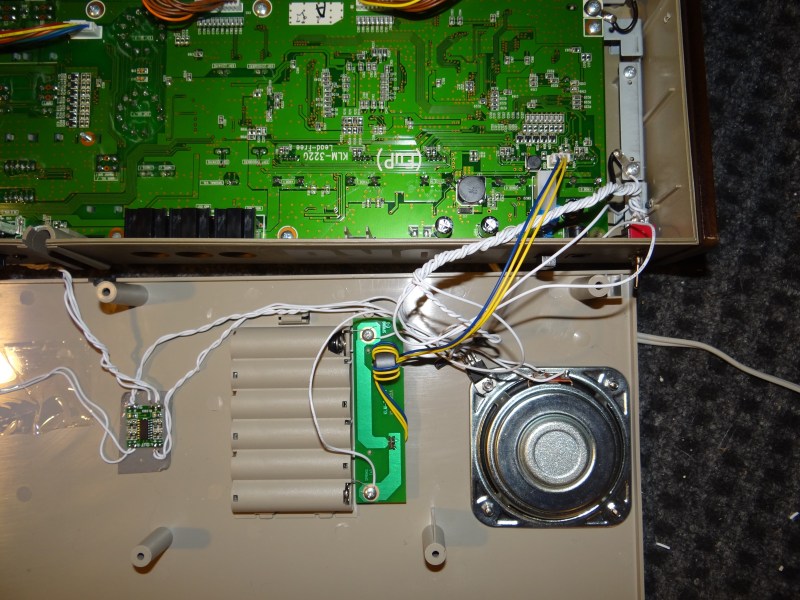When [Michael Wessel] bought his MicroKORG synthesizer/vocoder, he felt less than amused when two years later the MicroKORG S was released, with the ‘S’ standing for ‘sound’, apparently, for the 2+1 speaker system that was added to it. Undeterred, [Michael] figured out that both synthesizers are similar enough that one could likely add a similar speaker system to the original MicroKORG.
The similarities between the two products become apparent when one compares the original with its successor, with the latter seemingly mostly adding said speakers and more presets, along with a snazzy new exterior. (Although the 1970s styling of the original may have more fans.) As the embedded video shows, this mod is fairly clean.
At the core of this mod is a PAM8403-based class D amplifier board. The PAM8403 is a 3 W audio amplifier, originally produced by Power Analog Microelectronics (now Diodes). While not an amazing amplifier, it lends itself well for battery-powered applications like the MicroKORG. Rounding out the build is a 7805 linear regulator to get 5 V for the PAM8403, a few filter capacitors, a switch to turn the speakers on/off, and of course the speakers.
Although there’s quite a bit of space in the enclosure, most speakers tend to be large enough that this can be a bit of a squeeze. [Michael] found some low-profile 20 W full-range speakers that seem to work well for this purpose. To finish wiring this up, all it takes is a hole saw and a way to get the audio output from the MicroKORG.
In this mod, [Michael] opted to get the audio from the output jack on the back, but for a cleaner result it probably could be wired straight into the on-board header.
















It might just be my browser, but I don’t see any difference clicking between the “original” link and “successor” links.
Sounds like Tangerine Dream?
… one of the greatest Krautrock bands ever :-)
successor link is broken https://www.korg.com/us/products/synthesizers/microkorg_s/index.php
Thanks!
>While not an amazing amplifier, it lends itself well for battery-powered applications like the MicroKORG.
It is already *better* than your old favorite LM380, LM386 in terms of THD and power output. The only draw back is sometimes I can hear high frequency noise with no input.
You only get around 1W of decent audio which is plenty anyways. If you are using 4 ohms speakers and can tolerate quite a bit of THD (like 10%), then you’ll get 3W.
Things to do/watch out for:
– add big filter cap (like 470uF – 1000uF) to the power rail of the PAM8403 especially if you have long wires like OP
– LM7805 also needs its own filter caps. OP seems not to read the datasheet.
– Quite often the wrong resistors are used in the PAM8403 boards from China resulting in too much gain. See datasheet
LM7805 has its filter caps. They are 10 uF – is that OK? See picture here:
https://hackaday.io/project/172154/gallery#c25efdb9ae63317622dbc785ee8e522d
Well, for high frequency filter, some folks also add ceramic capacitors in parallel to the electrolytic capacitors. IMHO it sounds good enough the way it sounds (the not really “HiFi” loudspeaker will cut off high frequencies anyway…)
Getting a mild chuckle out of using a linear regulator with a switching amp. Pair that puppy up with a little high efficiency switching regulator. In the worst of cases you may need so scope the output of the regulator and figure out the switching frequency and build a filter network for it. The good news is the frequency will be most likely be high enough you can get by with small value parts.
My poor Korg MicroKorg spent the last decade in a box in the basement, together with a Korg ElecTribe. Maybe it’s time to release them again for some hacking and jamming… If they even work after all these years…
They are both pretty resilient machines and easy to fix if they don’t work immediately. The Microkorg has several well documented issues like the board fuse and relay coils that can be bypassed. The electribes I have seen and serviced almost always have issues in the early stages of the psu but rarely anything beyond that unless you have the tube model. Good luck and have fun :) Those are both really fun machines!